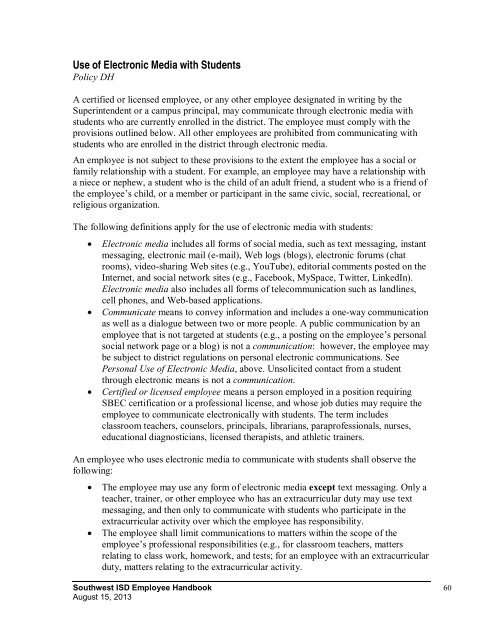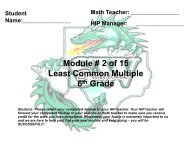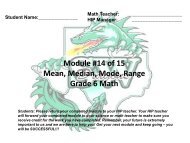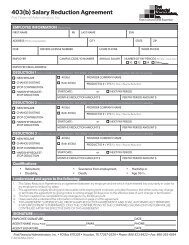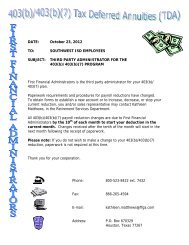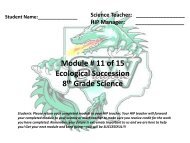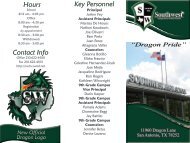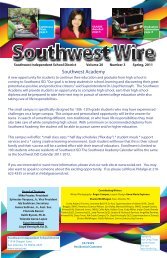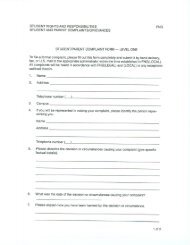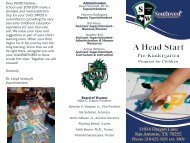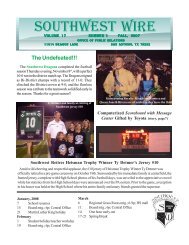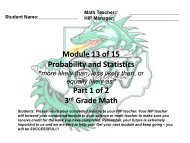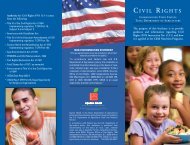12-13 Employee Handbook Cover.psd - Southwest ISD
12-13 Employee Handbook Cover.psd - Southwest ISD
12-13 Employee Handbook Cover.psd - Southwest ISD
You also want an ePaper? Increase the reach of your titles
YUMPU automatically turns print PDFs into web optimized ePapers that Google loves.
Use of Electronic Media with Students<br />
Policy DH<br />
A certified or licensed employee, or any other employee designated in writing by the<br />
Superintendent or a campus principal, may communicate through electronic media with<br />
students who are currently enrolled in the district. The employee must comply with the<br />
provisions outlined below. All other employees are prohibited from communicating with<br />
students who are enrolled in the district through electronic media.<br />
An employee is not subject to these provisions to the extent the employee has a social or<br />
family relationship with a student. For example, an employee may have a relationship with<br />
a niece or nephew, a student who is the child of an adult friend, a student who is a friend of<br />
the employee’s child, or a member or participant in the same civic, social, recreational, or<br />
religious organization.<br />
The following definitions apply for the use of electronic media with students:<br />
• Electronic media includes all forms of social media, such as text messaging, instant<br />
messaging, electronic mail (e-mail), Web logs (blogs), electronic forums (chat<br />
rooms), video-sharing Web sites (e.g., YouTube), editorial comments posted on the<br />
Internet, and social network sites (e.g., Facebook, MySpace, Twitter, LinkedIn).<br />
Electronic media also includes all forms of telecommunication such as landlines,<br />
cell phones, and Web-based applications.<br />
• Communicate means to convey information and includes a one-way communication<br />
as well as a dialogue between two or more people. A public communication by an<br />
employee that is not targeted at students (e.g., a posting on the employee’s personal<br />
social network page or a blog) is not a communication: however, the employee may<br />
be subject to district regulations on personal electronic communications. See<br />
Personal Use of Electronic Media, above. Unsolicited contact from a student<br />
through electronic means is not a communication.<br />
• Certified or licensed employee means a person employed in a position requiring<br />
SBEC certification or a professional license, and whose job duties may require the<br />
employee to communicate electronically with students. The term includes<br />
classroom teachers, counselors, principals, librarians, paraprofessionals, nurses,<br />
educational diagnosticians, licensed therapists, and athletic trainers.<br />
An employee who uses electronic media to communicate with students shall observe the<br />
following:<br />
• The employee may use any form of electronic media except text messaging. Only a<br />
teacher, trainer, or other employee who has an extracurricular duty may use text<br />
messaging, and then only to communicate with students who participate in the<br />
extracurricular activity over which the employee has responsibility.<br />
• The employee shall limit communications to matters within the scope of the<br />
employee’s professional responsibilities (e.g., for classroom teachers, matters<br />
relating to class work, homework, and tests; for an employee with an extracurricular<br />
duty, matters relating to the extracurricular activity.<br />
<strong>Southwest</strong> <strong>ISD</strong> <strong>Employee</strong> <strong>Handbook</strong> 60<br />
August 15, 20<strong>13</strong>


